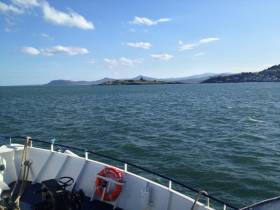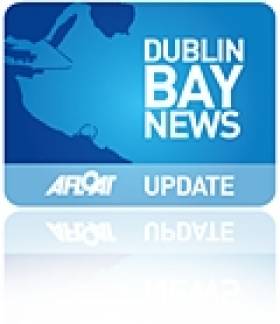Displaying items by tag: Summer of Heritage
Free Heritage Tours of National Maritime Museum of Ireland in Dun Laoghaire's Old Mariners' Church
Free self-guided tours of the National Maritime Museum of Ireland (NMMI) in Dun Laoghaire form part of the annual 'Summer of Heritage' programme run by the Heritage Office of Dún Laoghaire-Rathdown County Council, writes Jehan Ashmore
The Maritime Museum located aptly near the coast in the former Mariners Church which itself is one of a few custom built places of worship for seafarers remaining intact in the world today. Opposite of the museum in stark architectural contrast is the dlr Lexicon, flagship library of the council and a landmark almost opposite of the the harbour's East Pier on Dublin Bay.
Both venues are easily accesible from the nearby DART station and several bus services. There is also local car-parking at the Pavilion complex that neighbours the Lexicon.
Museum Tours of Maritime Heritage
This year's tours of the NMMI will be somewhat different due to the health and welfare of visitors and staff which is a primary concern for all and so the museum have made a few changes to accommodate the heritage-held programme.
Visitors will be able to experience a voyage through enthralling stories of discovery, heroism, war and disasters at sea. In addition to see nature and art inspired by the sea and also hear about innovative Irish inventions, scientists and local mariners which collectively form a treasure trove of matters maritime.
The tours are held every Monday and Wednesday until Wednesday, September 9th.
Each tour will be staggered apart, with one beginning at 11:00am and the other tour taking place at 11:30am.
Limited Tickets (click the NMMI website / Eventbrite here)
There will be a limit of six people per tour.
Noting the musuem will only have an allocation of 14 places per day and the NMMI advise if you know you are not going to be able to make it, please cancel your booking and let someone else take your place.
Covid-19
As of 10 August in a directive issued from the Department of Health, face coverings are mandatory in Museums and some other public spaces. Please ensure you have a face mask before entering the Museum to be compliant.
Patrons of the self-guided tours will be requested to strictly adhere to observing social distancing with people outside their household.
Brief background on Old Mariners Church
The museum’s greatest artefact is probably the former church itself as it is one of a few custom built places of worship for seafarers remaining intact in the world.
The Old Mariners' Church of the Church of Ireland was erected in 1836, to the design of Joseph Welland, which according to the publication ' New Life, for churches in Ireland' (2012) was for the benefit of many a sailor, who were based in the then harbour town named Kingstown where British Navy vessels used. All naval crew were obliged to attend Devine Service. Also according to Mary Hamilton, writing in th early 1900's, describes Welsh and Cornish fishing crew along with the local congregation, crowding the church, which, with its spacious galleries, could accommodate up to 1,000 worshippers.
The church closed in 1970 including the school building and residence which was sold off separately, however the former place of worship was leased from the Representative Church Body of the Church of Ireland to the Maritime Institute of Ireland (M.I.I.) which was founded in 1941 and also led to the formation of the NMMI.
Four years laters in 1974 the M.I.I. opened using the old church (having relocated from within the harbour) to the newly reconfigured and refurbished building that became their headquarters and museum albeit as the book describes for a 'peppercorn' rent. The building in more recent times was transferred to the museum.
The museum was open to its members and public alike over the decades until closing temporaily during the mid-2000's due to a deteriorating state of the old church building both outside and internally. Such conditions can be personally attested having observed with dismay water ingress near the pulpit and pigeons flying inside!
After securing government funding during the Celtic Tiger era this enabled an extensive refurbishment that ultimately led to the NMMI officially reopening on 5 June, 2012 by President Michael D. Higgins, patron of the museum from where that day the above photo was taken and published in the book by the Ulster Historic Churches Trust.
#BiosphereTours – Dublin Bay Biosphere Guided Tours begin today from Dun Laoghaire Harbour, Dublin and Howth and on every Wednesday until 14 June, writes Jehan Ashmore.
Dublin Bay which is internationally recognised for its wealth of marine wildlife and cultural heritage was in 2015 awarded a “UNESCO Biosphere”. The designation status from United Nations Educational, Scientific and Cultural Organisation was in recognition to unique places such as Dublin Bay. The biosphere is actively managed to promote a balanced relationship between people and nature. To find out much more, to get involved and events click here.
Dun Laoghaire-Rathdown County Council as part of the Dublin Bay Biosphere Partnership, encourage you to take this opportunity in appreciating our beautiful bay from a truly unique perspective.
In addition to marine wildlife (including ceteceans) there are stunning landscapes views of the Dublin Mountains and to the south in the bay is Dalkey Island. While off Howth Peninula with its cliffs, lies Ireland’s Eye and further offshore Lambay Island. In the far distance are also the Mountains of Mourne.
Manmade landmarks can also be observed, among them Joyce’s Martello Tower, Sandycove, the Poolbeg Lighthouse that marks the entrance to Dublin Port and the capital. On the bay's north side approaches to the port is another iconic coastal landmark the Baily Lighthouse.
Operating the Biosphere Tours in conjunction with Dublin Bay Cruises is the excursion vessel, St Bridget. The (pre-booked) tours up to Wednesday 14 June will run between 60-90 minutes duration depending on which route is taken.
Embarkation locations: Dun Laoghaire Harbour (East Pier), Dublin on the Liffey (Sir John Rogerson’s Quay) and in Howth Harbour (West Pier).
For more information on tours and cruise routes, times, charges and booking information, click here.
#SeafrontTours- The Seafront Memorials Tour is a free guided tour that is part of Dun Laoghaire-Rathdown County Council's annual Summer of Heritage programme.
The first tour begins this Sunday 5 July and will be held every Sunday throughout the summer until 6 September.
Meeting Point: Queen Victoria Fountain, Dún Laoghaire.
Wheelchair accessible.
This is an outdoor event.
Enjoy a tour of the coastal memorials in Dún Laoghaire including the Queen Victoria Fountain, George IV Memorial, the mailboat Leinster's anchor,Christ the King, the Crimean War Cannon and the 1895 Lifeboat Disaster.
Tour Time Start: 11.30am
One tour per day
One event per week
Tour duration: 60 mins
Maximum capacity: 20 people
For more information on other events download the Summer of Heritage brochure here
#SummerOfHeritage – The annual Summer of Heritage organised by Dun Laoghaire-Rathdown County Council continues its events programme until 7th September.
So there's still time to visit places of interest, among them those with direct links to matters maritime.
Click the following links below to previous postings to reveal further information to the following venues where all have FREE guided tours / walking tours on offer.
Seapoint Martello Tower, Dublin Bay
Seafront Memorials Tours, Dun Laoghaire Harbour
Martello Tower (No.7) & Fortification, Killiney
Noting all tours do not require pre-booking, yet it is advisable to turn up early!... as spaces are limited.
For further details of guided tours, download programme HERE and for locations, dates and times visit: www.dlrevents.ie or call (01) 204 7011
#SummerOfHeritage- The annual Summer of Heritage events programme organised by Dun Laoghaire-Rathdown County Council (DLRCoCo) started today.
Running over five days a week for the next ten weeks until 7 September the programme has some added new and exciting venues this year for you to see, visit and learn from. All for free! for adults and children alike.
Among the events which drew thousands of people in 2013 when visiting various heritage sites across the county was and will continue to be the Martello Tower at Seapoint where guided tours are held. A unique story told in a unique setting.
The tower is one of a series along with batteries built between Bray and Balbriggan in 1804-5 to repel a threatened French invasion.
The first tour starts tomorrow, 2 July (and every Wednesday plus all Sundays). Hourly tours of 4 held on both selected days (2pm-5pm) and are restricted to 15 persons. They are not wheelchair accessible.
This is both an indoor and outdoor event where proper footwear is essential, noting bare feet are not allowed. Access to roof is very restricted. Noting, children 'must' be accompanied by an adult.
For further details of the full programme of guided tours, download the Summer of Heritage brochure HERE and which also outlines locations, dates and times.
Or visit: www.dlrevents.ie or by contacting: (01) 204 7011
'Seafront Memorials' Tours of Dun Laoghaire Harbour
The tour which is free starts at the meeting point of the Queen Victoria Fountain which too forms part of the tour alongside the George VI memorial
and the Christ the King monument.
The outdoor event is part of the 'Summer of Heritage' which is organised by Dun Laoghaire-Rathdown County Council. The initiative is now in its fourth year and this year's highlight of the programme are tours of the newly renovated Seapoint Martello tower.
The coastal structure has been restored and is a fine example of these 19th century defensive forts, built along the coast to defend during the Napoleonic wars.
This summer also sees Carrickbrennan graveyard feature for the first time, the resting place of many sailors lost in maritime disasters since the 17th century.
Sightseeing along 'The Metals', a historic pathway that linked the quarry in Dalkey to the harbour in Dún Laoghaire also returns in the programme due to its popularity last year.
To read more about the the Summer of Heritage other free events in the arts, literature, sports, music and for the family, go to www.dunlaoghaire.ie/summer-of-heritage/ and www.dlrevents.ie/heritage11.html
- Events
- RNLI
- dlrcoco
- Dublin Bay News
- Dun Laoghaire Harbour
- Coastal Notes
- Dun Laoghaire News
- Seafront Memorials
- Guided Tours
- DunLaoghaireRathdown County Council
- DLR
- DLR events
- Martello Towers
- Seapoint Martello Tower
- The 'Metals'
- Queen Victoria Fountain
- King George VI monument
- Crimean War cannon
- Event news
- Napoleon
- Napoleonic Wars
- 1895 Dun Laoghaire Lifeboat Disaster
- RNLI Dun Laoghaire
- Christ the King monument
- Summer of Heritage

































































